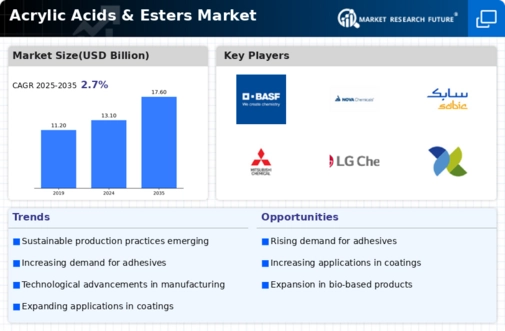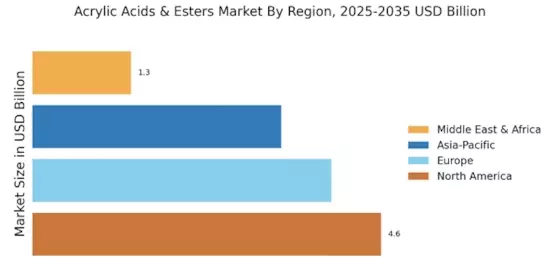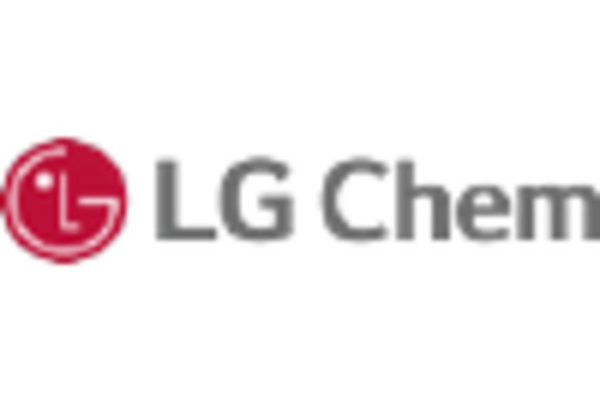Expanding Applications in Textiles
The Acrylic Acids & Esters Market is witnessing an expansion in applications within the textiles sector, where acrylic fibers are increasingly utilized for their durability and versatility. The textile industry is projected to grow at a rate of approximately 5% per year, with acrylic-based materials being favored for their lightweight and moisture-wicking properties. In 2023, the textile segment accounted for about 15% of the total market share, indicating a growing trend towards synthetic fibers. This shift is likely to be driven by the increasing demand for high-performance fabrics in sportswear and outdoor apparel. As manufacturers continue to innovate and develop new acrylic-based textile solutions, the market is expected to experience further growth, highlighting the potential of acrylic acids and esters in this sector.
Growth in Coatings and Paints Sector
The Acrylic Acids & Esters Market is significantly benefiting from the expansion of the coatings and paints sector. With a projected growth rate of around 4% annually, the demand for acrylic-based coatings is on the rise due to their excellent weather resistance and aesthetic appeal. These coatings are increasingly favored in both industrial and decorative applications, contributing to a substantial portion of the market. In 2023, the coatings segment represented nearly 25% of the total acrylic acids and esters market share. This growth is further fueled by the increasing focus on sustainable and low-VOC (volatile organic compounds) products, aligning with regulatory standards and consumer preferences. Consequently, manufacturers are investing in research and development to create innovative acrylic formulations, which is likely to enhance the competitive landscape of the acrylic acids and esters market.
Rising Demand in Adhesives and Sealants
The Acrylic Acids & Esters Market is experiencing a notable surge in demand for adhesives and sealants, driven by their extensive applications in construction, automotive, and packaging sectors. The increasing need for durable and high-performance bonding solutions is propelling the market forward. In 2023, the adhesives segment accounted for approximately 30% of the total acrylic acids and esters consumption, reflecting a robust growth trajectory. This trend is likely to continue as industries seek materials that offer superior adhesion properties and environmental resistance. Furthermore, the shift towards eco-friendly formulations is influencing manufacturers to innovate, thereby enhancing the overall market landscape. As a result, the acrylic acids and esters utilized in these applications are expected to witness sustained growth, indicating a promising outlook for the industry.
Technological Innovations in Production
The Acrylic Acids & Esters Market is being propelled by technological innovations in production processes. Advances in polymerization techniques and the development of more efficient catalysts are enhancing the production efficiency and quality of acrylic acids and esters. In recent years, the introduction of continuous production methods has reduced operational costs and improved yield rates, making it more feasible for manufacturers to meet the rising demand. This technological evolution is expected to contribute to a projected market growth of around 6% annually over the next five years. Furthermore, the integration of automation and digital technologies in manufacturing processes is likely to streamline operations, thereby enhancing competitiveness within the acrylic acids and esters market. As these innovations continue to unfold, they may redefine production standards and capabilities in the industry.
Increasing Focus on Sustainable Practices
The Acrylic Acids & Esters Market is increasingly influenced by a focus on sustainable practices. As environmental concerns gain prominence, manufacturers are exploring bio-based acrylic acids and esters as alternatives to traditional petroleum-derived products. This shift is indicative of a broader trend towards sustainability, with many companies committing to reducing their carbon footprint and enhancing product recyclability. In 2023, the market for bio-based acrylics was estimated to represent approximately 10% of the total acrylic acids and esters market, reflecting a growing consumer preference for eco-friendly products. This trend is likely to accelerate as regulatory frameworks become more stringent and consumers demand greener solutions. Consequently, the acrylic acids and esters market may witness a transformation, with sustainability becoming a key driver of innovation and growth.


















Leave a Comment